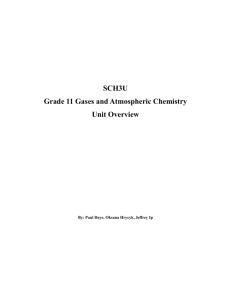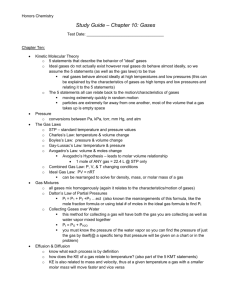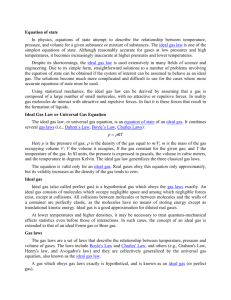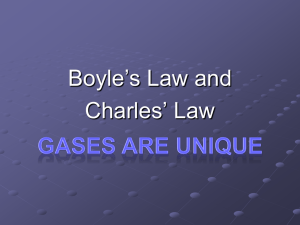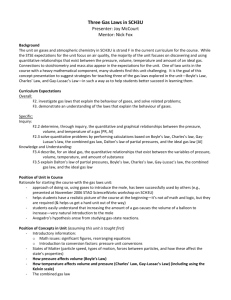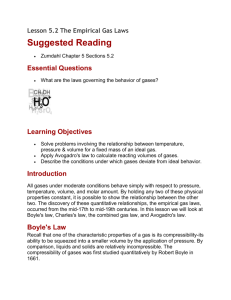Chemistry Unit_Plan_Gr.11
advertisement
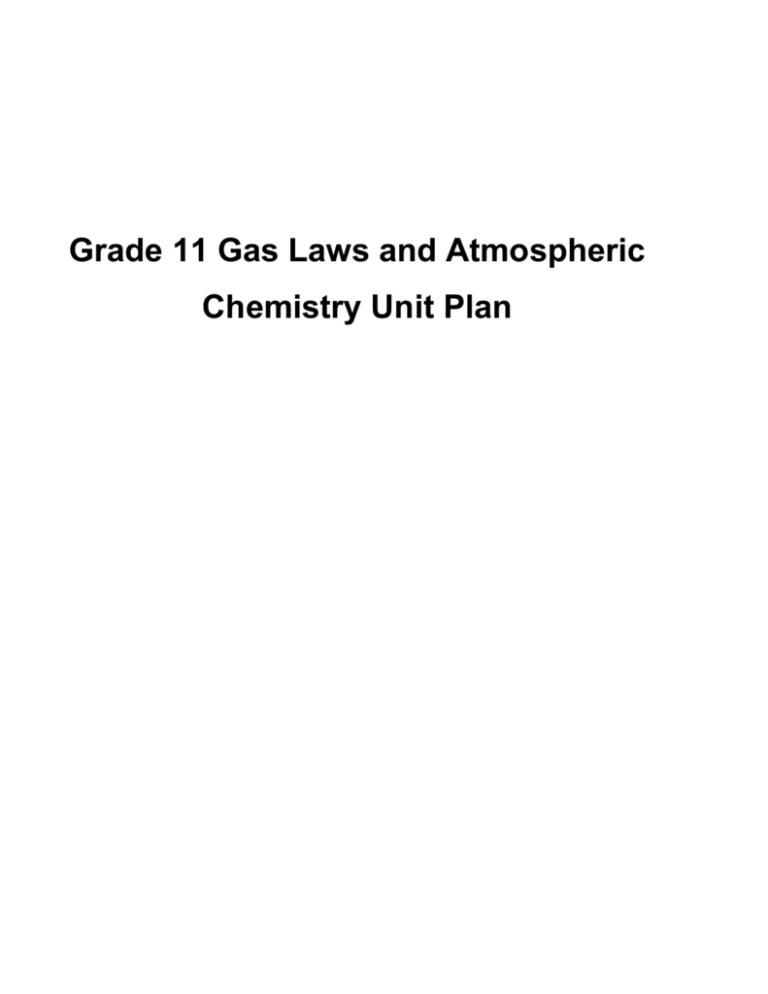
Grade 11 Gas Laws and Atmospheric Chemistry Unit Plan Ontario Curriculum 2008: Grade 11 Gas Laws and Atmospheric Chemistry OVERVIEW This course enables students to deepen their understanding of chemistry through the study of the properties of chemicals and chemical bonds; chemical reactions and quantitative relationships in those reactions; solutions and solubility; and atmospheric chemistry and the behaviour of gases. Students will further develop their analytical skills and investigate the qualitative and quantitative properties of matter, as well as the impact of some common chemical reactions on society and the environment. Fundamental Concepts Matter Big Ideas Properties of gases can be described qualitatively and quantitatively, and can be predicted. Air quality can be affected by human activities and technology. People have a responsibility to protect the integrity of Earth’s atmosphere. Energy Structure and Function Sustainability and Stewardship Overall Expectations By the end of Grade 11, students will: 1. analyze the cumulative effects of human activities and technologies on air quality, and describe some Canadian initiatives to reduce air pollution, including ways to reduce their own carbon footprint; 2. investigate gas laws that explain the behavior of gases, and solve related problems; 3. demonstrate an understanding of the laws that explain the behavior of gases. Specific Expectations By the end of grade 8, students will: F1.1 analyse the effects on air quality of some technologies and human activities (e.g., smelting; driving gas-powered vehicles), including their own activities, and propose actions to reduce their personal carbon footprint [AI, C] Sample issue: Gas-powered lawnmowers cut grass quickly and efficiently, but they emit greenhouse gases. However, there are several alternatives, including electric or push mowers or replacing lawn with a naturalized garden. Sample questions: In what ways does our consumption of products imported from distant countries affect our carbon footprint? How might “eat local–buy local” initiatives help to reduce our carbon footprint? How effectively does the use of digital communications for business reduce our carbon footprint? F1.2 assess air quality conditions for a given Canadian location, using Environment Canada’s F2.1 use appropriate terminology related to gases and atmospheric chemistry, including, but not limited to: standard temperature, standard pressure, molar volume, and ideal gas [C] F2.2 determine, through inquiry, the quantitative and graphical relationships between the pressure, volume, and temperature of a gas [PR, AI] F2.3 solve quantitative problems by performing calculations based on Boyle’s law, Charles’s law, Gay-Lussac’s law, the combined gas law, Dalton’s law of partial pressures, and the ideal gas law [AI] F2.4 use stoichiometry to solve problems related to chemical reactions involving gases (e.g., problems involving moles, number of atoms, number of molecules, mass, and volume) [AI] F2.5 determine, through inquiry, the molar volume or molar mass of a gas produced by a chemical reaction (e.g., the molar volume of hydrogen gas from the reaction of magnesium with hydrochloric acid) [PR, AI] Air Quality Health Index, and report on some Canadian initiatives to improve air quality and reduce greenhouse gases (e.g., Ontario’s Drive Clean program to control vehicle emissions) [AI, C] F3.1 identify the major and minor chemical components of Earth’s atmosphere F3.2 describe the different states of matter, and explain their differences in terms of the forces between atoms, molecules, and ions F3.3 use the kinetic molecular theory to explain the properties and behaviour of gases in terms of types and degrees of molecular motion F3.4 describe, for an ideal gas, the quantitative relationships that exist between the variables of pressure, volume, temperature, and amount of substance F3.5 explain Dalton’s law of partial pressures, Boyle’s law, Charles’s law, Gay-Lussac’s law, the combined gas law, and the ideal gas law F3.6 explain Avogadro’s hypothesis and how his contribution to the gas laws has increased our understanding of the chemical reactions of gases Unit Overview – Outline of Lessons Day Lesson Lesson Strategy and Assessment Expecta tion Code Evaluation 1 Greenhouse Effect Present Key Questions for this lesson F1.1 • F1.2 During the activity, the teacher walks around, looking at individual concept maps • What do you think about when you hear the term “Climate Change?” What is the evidence that Earth’s climate is changing? Do you think people have caused Earth’s climate to change? How do you think climate change will impact the world? North America? Yourself? F1.2 F3.1 The teacher could also collect the initial concept maps, to use as a diagnostic, to help plan future lessons. Teacher will present a slideshow on the Effect of Ozone. Students will know that the atmosphere consists of different gases F1.2 Teacher will observe and question students as they conduct research. Activities – Teacher will provide organizer and students will research air quality for Canadian cities and report on initiative to reduce air pollution. F3.1 Diagnostic test covering the entire unit. Class discusses answers. F2.1 • • Hook: You Tube video Teacher will present a slideshow presentation on The Greenhouse Effect Activities - Students draw a mind map/concept map on climate change. If they how to use the Ministry-licensed software, Smart IDEAS, they can work in the computer lab. The concept map should show initial knowledge about climate change. 2 3 Ozone and Components of the atmosphere Introduction to gases Definition: What is a gas? Watch You Tube video or Discovery video on gases Power Point discussion on the Kinetic F1.2 F2.1 Collect test for diagnostic purposes Molecular Theory 4 Kinetic Molecular Theory and Unit Conversions for the Gas Laws Class discussion and PowerPoint on Kinetic Molecular Theory continued. F2.1 F3.3 Students will complete and submit the worksheet. How to state standard atmospheric pressure in the following units: atm, mm Hg, torr, cm Hg, in. Hg, psi, and kPa. How to convert a given gas pressure into a different unit of measurement. Activities - Students will work to complete a table showing gas conversion units 5 BOYLE’S LAW CHARLES’ LAW LAB 1 Teacher will provide brief lecture and discussion on the Boyle’s Law and Charles’ Law. Activities: Students will work in small groups perform the following experiments to demonstrate Boyle’s Law and Charles’ Law Workstations: o o o o o o Balloon in a Bell Jar Marshmallow in a Bell Jar Shaving Cream in a Beaker in a Bell Jar Cartesian Diver Balloon on a Flask Balloon Outside vs. Balloon Inside Students will complete Gizmos Activity online and complete the Student Activity Sheet. http://www.explorelearning.com/index.cf m?method=cResource.dspDetail&Reso urceID=422 Exit Ticket. Complete one question F2.1 F2.2 F2.3 F3.1 F3.3 F3.4 Students will complete exit ticket before the end of class. Students will submit worksheet completed for homework. 6 GAY-LUSSAC’S LAW COMBINED GAS LAW Teacher will provide PowerPoint presentation and lead discussion on Gay-Lussac’s Law and the Combined Gas Law F2.3 Collect Exit Tickets Teacher listens to groups discussion Activities - Demonstrations Students will work in small groups to perform the following experiments to demonstrate Gay-Lussac’s Law . Observes students conducting experiments. Volume is constant while pressure and temperature change. o o o Egg on a Flask Drinking Novelty Bird Novelty Hand Boiler Students will work in their groups to complete a related work . Exit Ticket: Students will write and submit explanations for 3 everyday occur of these laws 7 Ideal Gas Law and the Combined Gas Law Teacher will demonstrate problem solving methods using the Ideal and Combined Gas Law. Activities: Students will work in small groups to solve problems quantitative problems by performing calculations based on Boyle’s law, Charles’s law, GayLussac’s law, the combined gas law, and the ideal gas law Teacher will facilitate discussion around these problems. F2.1 F2.2 F2.3 Teacher listens to student discussions. Addresses any misconceptions F3.4 Students will complete worksheet. 8 Avogadro’s Law Teacher will provide PowerPoint and lead discussion on Avogadro’s Law. F3.6 Students will work on related problems. Culminating Task Assigned. 9 Quiz Review and Project Work Period Students work on Gas Laws review sheet and work in groups on Culminating Task 10 Quiz Students will write a quiz covering the content they have learned. Collect Quiz 11 THE VAPOR PRESSURE CONCEPT Teacher will lead discussion on the concept of vapor pressure and introduce the relationship between vapor pressure and temperature. F2.1 Students will complete activity based on the oxygen composition in the atmosphere 12 Dalton’s Law of Partial Pressures Teacher leads discussion and provides examples of how to use Dalton's Law of Partial Pressures to predict the pressure of a gas mixture F3.5 Collect exit ticket. F2.3 Students work on practice problem. Exit Ticket: Complete a reflection on how our lives are affected by gases 13 Gas Stoichiometry Teacher provides practice problem which the completes collectively F2.4 Students will work in small groups to complete worksheet. 14 LAB 1: Production of Hydrogen Gas Objectives: Experimentally determine the volume of gas that produced. LAB 2: Students will perform an experiment to observe the Reaction of Magnesium with Hydrochloric Acid In this experiment students will determine the volume of the hydrogen gas which is produced when a sample of magnesium reacts with hydrochloric acid. The volume of the hydrogen gas produced will be measured at room temperature and pressure. Students will obtain data and answer question from a worksheet. 15 Work Period Work Period to complete Lab 1 and Culminating Task 16 Presentations Student Presentations F2.5 Collect lab report next day. 17/18 Presentations Student Presentations 19 Test Review Teacher will engage the class in review activities and provide review questions. 20 Unit Test F1.1 F3.6



